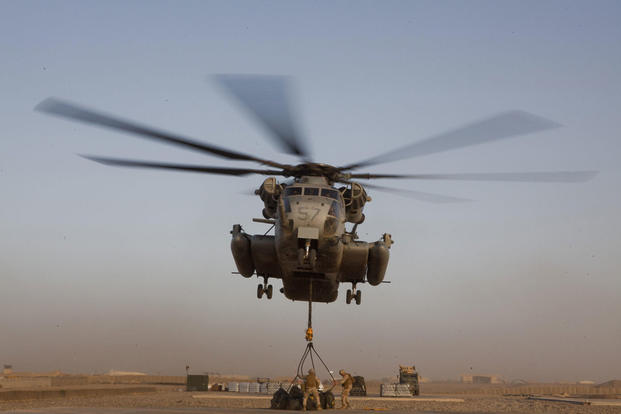A CH-53E Super Stallion experienced a 'hard landing' Wednesday during a training flight at Marine Corps Air Station Yuma, Arizona, but the five Marines aboard were unhurt, Marine Corps officials said today.
The Sikorsky-made heavy-lift helicopter was conducting a training mission in support of Yuma's Weapons and Tactics Instructor school when the mishap took place, 1st Lt. Gabriel Adibe told Military.com. Adibe said he could not provide any details about the state of the aircraft or the nature of the incident as it remained under investigation.
The mishap was first reported Thursday by Marine Corps Times.
All five of the Marines aboard the aircraft were assigned to 3rd Marine Aircraft Wing, Adibe said. They safely left the aircraft on their own after it went down and did not require hospitalization, he added. The incident took place around 1 p.m. local time.
The mishap comes just days after the Pentagon approved the Navy's request to begin production on the CH-53K King Stallion, the Lockheed Martin-Sikorsky replacement for the aging Super Stallion. There are currently 146 Super Stallions in the Marine Corps aviation inventory with an average age of nearly 28 years, according to the 2017 Marine Corps Aviation Plan released late last month.
The commandant of the Marine Corps, Gen. Robert Neller, said that Super Stallions were the hardest worn of any Marine Corps aviation platform, telling a congressional panel last year that the service "probably kept [CH-53s] in theater a little bit too long" following 15 years of war in Afghanistan and Iraq, deferring needed maintenance. But the CH-53E is now in an intensive recapitalization program that will continue until the introduction of the King Stallion near the end of this decade.
It's not yet clear if the incident was a result of equipment failure, human error, or some other cause. It's the first hard landing or crash for a Super Stallion since January 2016, when two of the aircraft collided over water during night training off the coast of Hawaii.
-- Hope Hodge Seck can be reached at hope.seck@military.com. Follow her on Twitter at @HopeSeck.
Don't Miss a Single Military.com Story
To read the full article and get exclusive benefits, sign up today.
It’s FREE
Why am I seeing this? Visit our FAQs



























